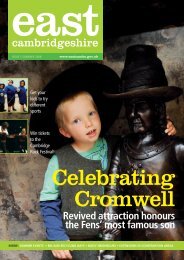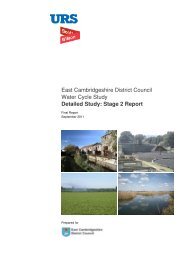6. Soham Conservation Area - East Cambridgeshire District Council
6. Soham Conservation Area - East Cambridgeshire District Council
6. Soham Conservation Area - East Cambridgeshire District Council
You also want an ePaper? Increase the reach of your titles
YUMPU automatically turns print PDFs into web optimized ePapers that Google loves.
11.1.5 The boundary of the Recreation Ground accessed from Fountain Lane<br />
is said to follow at least part of the boundary of a Saxon ecclesiastical<br />
enclosure and in the 19 th century was The Place Estate. Today the<br />
remains of the mansion are in use as a pavilion and the 11 acres of the<br />
estate that remain are an important open green space with good<br />
mature trees in the heart of the village. It is therefore proposed to<br />
include the Recreation Ground within the conservation area.<br />
11.1.6 Clay Street contains a variety of buildings, the most striking of which<br />
are the two former schools now converted into private residences and<br />
a library. There are also 19 th century terraces and a mixture of houses<br />
from different periods including a former public house. Clay Street runs<br />
east into Red Lion Square, the western side of which is currently<br />
outside the conservation area. It is therefore proposed to include the<br />
whole of Clay Street, No.2 College Road and the Baptist Church on<br />
Red Lion Square within the conservation area.<br />
11.1.7 Nos.3 & 5 Brook Dam Lane are a pair of 19 th century properties which<br />
form a short terrace with No.1 Brook Dam Lane and help to enclose the<br />
street before it opens up into more modern development. No.3 retains<br />
its plate sash windows and both properties have ridge stacks. It is<br />
therefore proposed to include Nos.3 & 5 Brook Dam Lane within the<br />
conservation area.<br />
11.1.8 Sand Street contains many fine detached houses from the 19 th century<br />
and early 20 th century houses as well a former lodge house and a 19 th<br />
century terrace. The double fronted properties are more ornate version<br />
of the gault brick villas found further north within the conservation area<br />
and the other buildings along the northern end of Sand Street are also<br />
of good quality retaining many traditional features. It is therefore<br />
proposed to include Nos.2-18 (evens) and Nos.1-13 Sand Street within<br />
the conservation area.<br />
11.1.9 The distinct sub-area around the mills on the village’s western edge<br />
has a very different character to that of the main village, but is an<br />
important part of the village’s development and has been settled since<br />
early in the village’s history. The cluster of buildings that surround the<br />
mills and the scattering of buildings that encroach upon Angle Common<br />
form an attractive group, dominated by the mill complex. The ‘pond’<br />
formed by <strong>Soham</strong> Lode adjacent to the mill is framed by overhanging<br />
trees and, together with the backdrop of Angle Common, creates an<br />
attractive rural feel. It is therefore proposed to include the area<br />
covering Nos.1-17 Angle Common, and the whole of Mill Corner within<br />
the conservation area.<br />
11.2 Removals<br />
11.2.1 Fox Wood South, Rosemary Gardens, Honeysuckle Close, Yew Trees<br />
and Guntons Close are all modern housing estates and infill<br />
developments that have been built after the original designation of the<br />
conservation area boundary and lack the character of the traditional<br />
44






